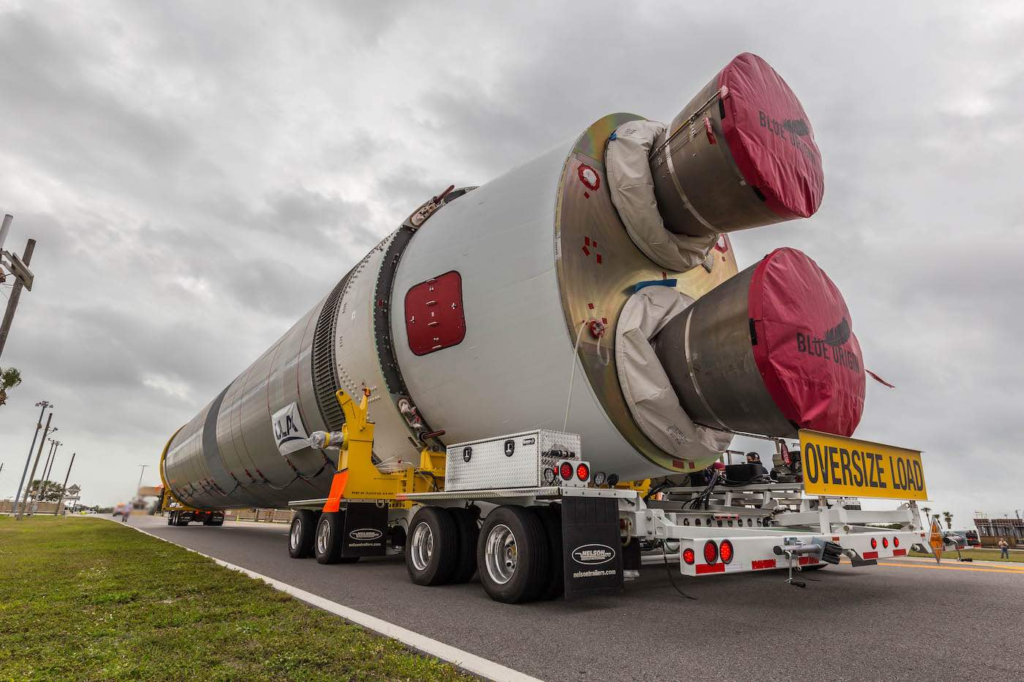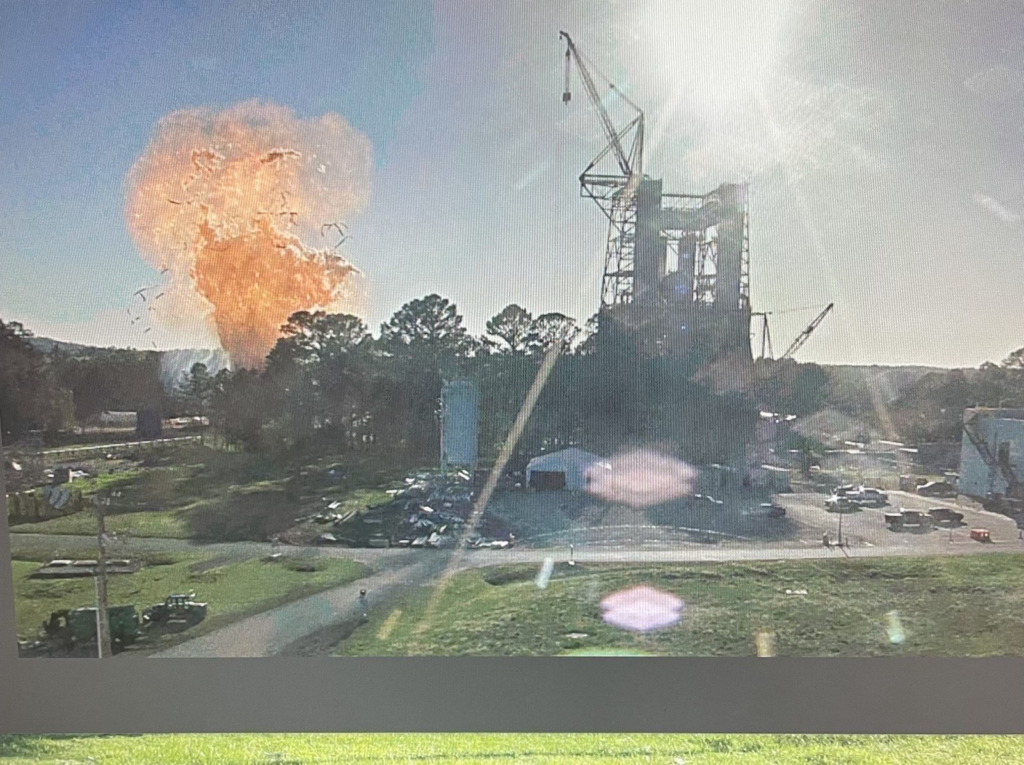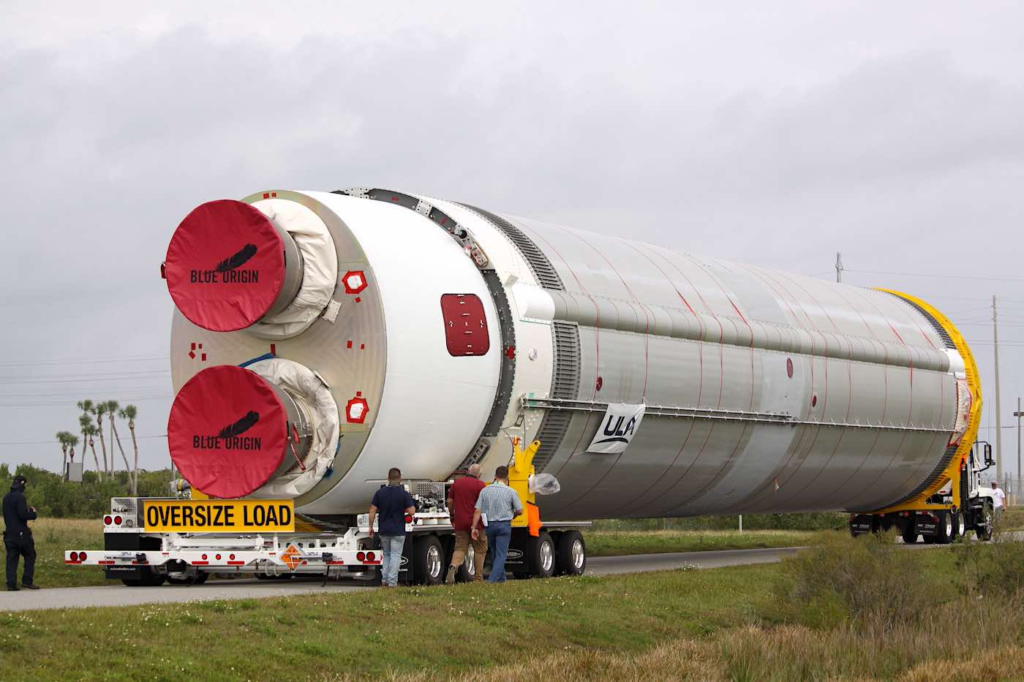
A Closer Look At The Explosion of ULA’s Vulcan Upper Stage
United Launch Alliance has been very busy over the last couple of months as they prepare for the first orbital test flight of Vulcan. The recent work has included stacking the rocket, moving it to the pad, and performing some initial testing ahead of the flight readiness firing. Currently scheduled for early May, there is still quite a bit of work left before this rocket takes off.
Unfortunately, the recent explosion of a separate Centaur upper stage at a test stand is not helping. Initially, we learned that an anomaly occurred while testing this stage. Only days ago, more information and images came out that showed the extent of this mishap. While this doesn’t directly affect the first flight of Vulcan, it does bring up some concerns and could add delays.
This comes in addition to more work needed on the main test article and new developments with the payloads. All of which factors into the rocket’s launch date which has already been pushed back a decent bit. Here I will go more in-depth into the recent upper stage explosion, the first flight of Vulcan, what to expect in the coming weeks, and more.
Upper Stage Explosion

Starting on March 29th, the day of the incident, ULA CEO Tory Bruno tweeted saying, “Keeping you posted: During Qual testing of Centaur V structural article at MSFC, the hardware experienced an anomaly. This is is why we thoroughly & rigorously exercise every possible condition on the ground before flight. Investigation is underway. Vulcan will fly when complete.” At this point, this was practically all we knew about the anomaly. That was until a few days ago when a new image came out that sparked additional conversation and updates.
The image shows the anomaly of the upper stage where a large fireball of hydrogen can be seen to the left of Blue Origin’s rocket engine test stand. In regard to this image, Tory Bruno commented, “Most of what you’re seeing is insulation and smaller bits from the test rig. One piece of the hydrogen tank’s dome, about a foot square, ended up a few feet away. The test article is still inside the rig and largely intact, which will significantly help with the investigation”
This incident was recorded on video cameras operated by Blue Origin, which is restoring a nearby test stand. Afterward, however, reports were coming out that ULA had asked Blue Origin to delete the footage. Tory responded to a similar comment mentioning, “Incorrect. @blueorigin was a great partner. They immediately reached out to let us know they caught the event from their engine stand and offered any needed help. We asked them to secure the video, send a copy to NASA to send to us (which is the protocol)”
Moving on, the most important part of this anomaly is figuring out exactly what went wrong, and whether or not it will delay or have an effect on Vulcan’s first flight. In one final tweet, when asked if the test simulated normal flight loads or higher loads, Tory responded, “Kind of. The universe of possible load states have mutual exclusivity and are done separately. This case was an extreme limit case, but was also preceded by over a dozen other extreme cases, which is, obviously, not something that any given single tank would ever experience.” This is overall good news but by no means something to ignore.
In the grand scheme of things, the loss of the Centaur upper stage does raise questions about ULA’s schedule for the first launch of Vulcan. Eric Berger reported that “The fact that ULA was still doing qualification testing of the Centaur upper stage suggests it was also a pacing item for the new launch vehicle. Although this Centaur V upper stage is based on a heritage design, the new version nonetheless has significant upgrades.” As of right now, even ULA itself has very little information on exactly what went wrong. An investigation has no doubt begun and they will start gathering more data in the coming weeks. Ideally, not too long from now they let the public know what went wrong during that upper stage test.
Vulcan Cert-1 Flight

Whether or not this recent anomaly delays Vulcan’s first flight, other unrelated things might. By around October of last year, ULA had planned to ship the rocket in November and complete the flight readiness firing in December. This would result in a launch very early this year. In reality, the stages were shipped months later than the expected date and we are still a ways away from the final static fire. Publicly, ULA has set May 4th as the target date Vulcan’s debut launch. However, with less than a month between now and that date, we likely will see it pushed back based on current progress.
Back in the middle of March, ULA began tanking demonstrations at Cape Canaveral Space Force Station, Florida. The pathfinder tests filled the Vulcan first stage and Centaur V upper stage with cryogenic propellant on separate days to validate performance of the stages, Vulcan Launch Platform (VLP), Space Launch Complex-41 facilities and ground support systems. The tests, which also verified countdown steps, procedures and timelines, were successfully performed on March 10 on the Vulcan booster stage and March 16 on Centaur V.
With this complete, the next step in the countdown to the inaugural launch includes conducting a Wet Dress Rehearsal (WDR) to practice the day-of-launch activities and then performing a Flight Readiness Firing (FRF) to complete the full Terminal Countdown sequence, ignite the engines and demonstrate a hot-fire abort recycle and safing. After the anomaly, ULA spokesperson Jessica Rye said, “We are conducting an investigation and will fly when we believe it is safe to launch. We will not know the impact to the launch date until we learn more information from the investigation.”
In addition to this, it was reported that ULA asked the primary customer for the Cert-1 mission, Astrobotic, to refrain from shipping its Peregrine lander to the launch site. The lunar lander remains at the company’s facilities in Pittsburgh, waiting for a green light from the rocket company. The first launch will send Astrobotic’s Peregrine commercial lunar lander to intercept the Moon, deploy two Project Kuiper prototype broadband satellites into low Earth orbit for Amazon, and carry a Celestis memorial payload into deep space. ULA typically waits until the last second to ingrate the payloads to ensure no pre launch testing anomaly could damage them.
Recent testing of the main rocket also provided some alright results. Tory Bruno said in a quote, “Booster was a clean repeat of last time. Centaur went well, but this was the first time. There was some learning specific to the ground system. We are tuning up some procedures and software to have that all in place for the WDR.”
With everything that’s going on, time is running out for ULA to complete the development of Vulcan and fly two certification missions this year. The company was aiming for this because it would allow the vehicle to begin flying national security payloads for the Space Force. To be more specific, this first commercial mission is part of ULA’s requirement to meet the U.S. Space Force certification of its new launch vehicle. Late last year, Mark Peller, vice president of Major Development, stated “We are committed to ensuring we fly the first certification mission and stay on schedule to achieve U.S. Space Force certification of Vulcan in advance of our first national security space mission in the 4th quarter of 2023.” In order for this to actually happen, Vulcan needs to launch soon and successfully.
A big part of this mission also has to do with the BE-4 engines installed on Vulcan’s first stage. This flight will be the first ever launch of BE-4 and has quite a lot riding on its success. Vulcan also integrates up to six Northrop Grumman Graphite Epoxy Motor (GEM) 63XL Solid Rocket Boosters (SRBs). They are constructed out of a graphite-epoxy composite with the throttle profile designed into the propellant grain. GEM solids supported the Delta II and Delta IV rockets, and the GEM 63 variant will fly on ULA’s Atlas V rocket prior to the first Vulcan launch.
Lastly, Vulcan will rely on two RL10C engines to power its second stage. Logging an impressive record of nearly 400 successful flights and nearly 700 firings in space, RL10 engines, manufactured by Aerojet Rocketdyne, harness the power of high-energy liquid hydrogen. The RL10 boasts a precision control system and restart capability to accurately place payloads into orbit. At the very top, the spacecraft is encapsulated in a 5.4-m- (17.7-ft-) diameter payload fairing (PLF), a sandwich composite structure made with a vented aluminum-honeycomb core and graphite-epoxy face sheets. The bisector (two-piece shell) PLF encapsulates the spacecraft. The payload attach fitting (PAF) is a similar sandwich composite structure creating the mating interface from the spacecraft to the second stage and payload fairing. The PLF separates using a debris-free horizontal and vertical separation system with spring packs and frangible joint assembly. This system among many others will be put to the test hopefully around one month from now.
Conclusion
ULA has a lot on its plate with the preparation for Vulcan’s first ever launch. Unfortunately, an anomaly with a different Centaur upper stage and other delays are putting pressure on the May 4th launch date. We will have to wait and see how it progresses and the impact it has on the space industry.
